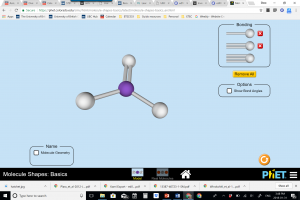Technology is a tool – something that helps us improve or accomplish something we couldn’t do before. It may be designed by us, it augments our own abilities, but is outside of ourselves. An ideal TELE is one that immerses students into a deep learning experience into experiencing a concept that could not be shown otherwise, or in a new and collaborative way through the use of technology. This experience must go beyond the traditional experience in some way.
For example, performing a virtual pig dissection is not really a TELE in my opinion, as it gives no extended experience, but doing a human autopsy would be. Writing a digital lab report is not a TELE, but determining molecular shapes using a PhET simulation is. Likewise, posting a reflection on-line or creating a slideshow are not TELEs, but having a knowledge forum discussion or creating a collaborative presentation would be.


Hi David,
I think that you’re right. If you are simply substituting the tech for something that can otherwise be done with a traditional tool it would not be considered a TELE. In my class, for instance, I have my students do their writing on Pages’ or Word but that is not enhancing the learning it is just substituting paper and pencil with a laptop. When I have my students create interactive presentations using things like Explain Everything and VideoScribe and use tools such as Hummingbird duo to show their learning that is what I consider a TELE.
Thanks for your post,
Sarah
Well said, Sarah. There is no real point to having technology unless it extends us beyond where we were before. There are indeed so many tools and opportunities for this…
Dear David,
I like how you suggested knowledge forums as an important part of extending the classroom. Given this, educational opportunities are boundless. Learning is a mental exercise and it requires regular practice. Thus, TELE can help expand learning time and scope.
Alice
I think one of the keys of constructivism is that we can all contribute to our own and others’ learning. We can learn from each other.
Hi David
I like the fact that you brought up the virtual pig dissection. I have to agree with you. In my online HS science classes, I have many virtual labs — but I am slowly trying to find replacement activities that students can do with materials they can find around the home — maybe not the pig dissection.
I wonder if the virtual pig lab would be beneficial prior to doing the actual live dissection?
A good next step might be to determine what an effecting virtual lab should include.
Please make sure to include citations in your posts.
Christopher
Hi David, I really enjoyed this post. It was short and to the point, and well-written. Your musings on tech existing outside ourselves reminded me of some readings on transactive memory and what role it plays in the design of a TELE (a little perusing while replying to this lead me to this which seems interesting: https://ideas.repec.org/h/wsi/wschap/9789812702081_0005.html)
Specifics of transactive memory aside, I think the concept ties in nicely to the concept of using digital tech to foster collaboration.
Some of your examples suggest little collaboration (human autopsy, determining molecular shapes using PhET) while others highlight it (knowledge forum discussion, collaborative presentation). Do you think that collaboration is a key component to the design of a TELE? Or do you think that a single student can benefit equally well from TELEs that offer isolated experiences?
Hey David,
I can second (third?) what others said in applauding your use of the pig dissection in your example. I remember when thinking through that as an example, it struck me as a lesser learning experience than cutting into an actual pig. I vividly remember my pig dissection in high school. The smell. The feeling as the scalpel cut through the flesh. The texture of the different organs. All of those are tangible learning experiences that would be missed if doing a virtual dissection.
There is definitely a genre of classroom technology use that simply makes life easier for teachers. I often give my students multiple choice quizzes using Socrative. It saves me the time of marking, and gives them quicker results. A real win-win most of the time. But definitely not a use of technology that really enhances their learning. It just makes life easier. I feel a virtual pig dissection is the same as this. The teacher doesn’t need to order and pay for pigs. They don’t need to give an in-depth instruction about scalpel usage. They just direct students to the website, and it’s done in one class.
It is essential that we make the distinction between technologies that make the classroom more efficient, and those that lead to quality TELEs.